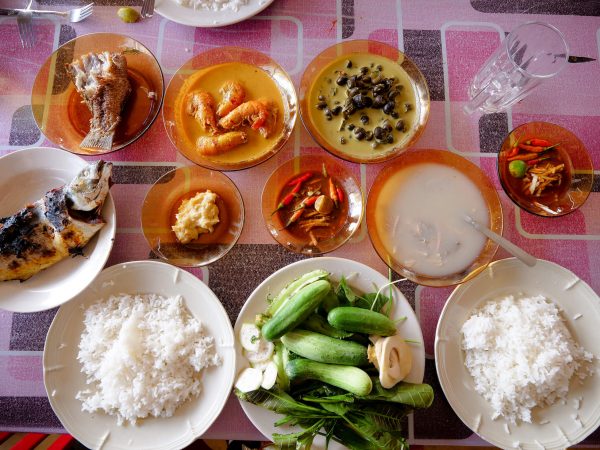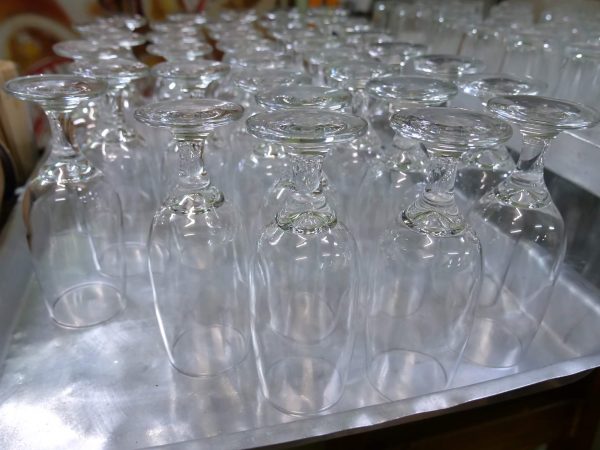
If there’s one thing you absolutely can’t miss when you Travel for Food in Salvador, it is this food right here – the name is ‘Acarajé.’
Acarajé is so well-loved in Salvador, and such an incredible street food, in my opinion its a snack worth visiting just to eat it!
Let me share with you all the details of acarajé – a food you absolutely have to have when you are in Salvador, in the state of Bahia, Brazil.
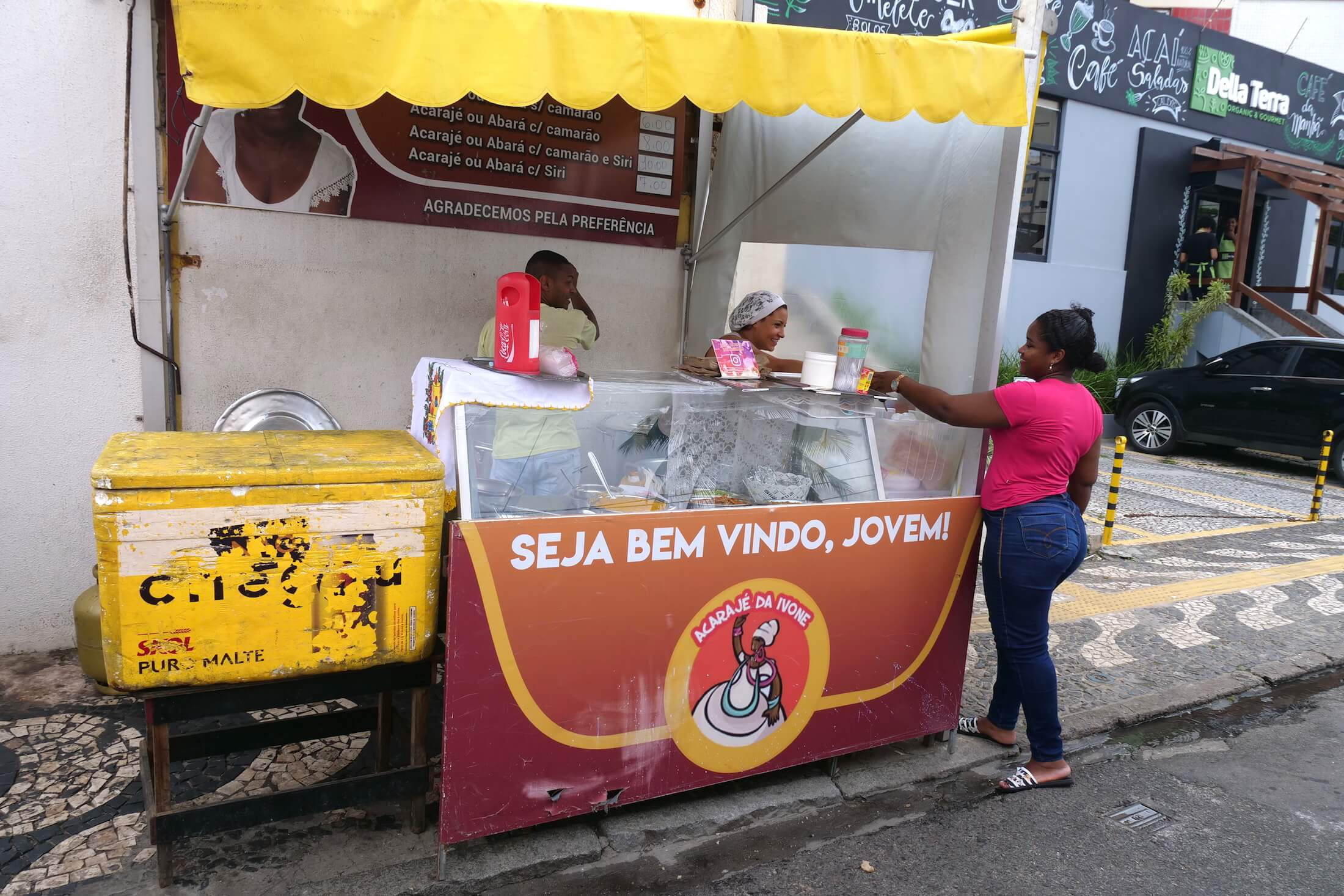
In my opinion, this beautiful food will undoubtedly make the list of ‘Love at First Bite’ for any eater, anywhere, ever.
What is Acarajé?
Acarajé is a food that comes directly from West African food traditions, and yet is so totally and completely loved by the locals of Salvador, Brazil.
At first glance it is beautiful as well, looking something like a deep-fried rainbow of Amazon jungle goodness wrapping around a heart of African-style starchy and hearty filling (see it all in the YouTube video here).
The local recipe for Acarajé blends simple and filling ingredients common in West-Central African food, with the vibrant flavors and local ingredients found here in Eastern Brazil.
And it is definitely one of the most delicious street snacks I’ve ever had in my entire life.
Brazilian street food tour in Salvador!
You can check out all the places we ate in Salvador on this ultimate Brazilian street food tour. Check out the full video on YouTube here.
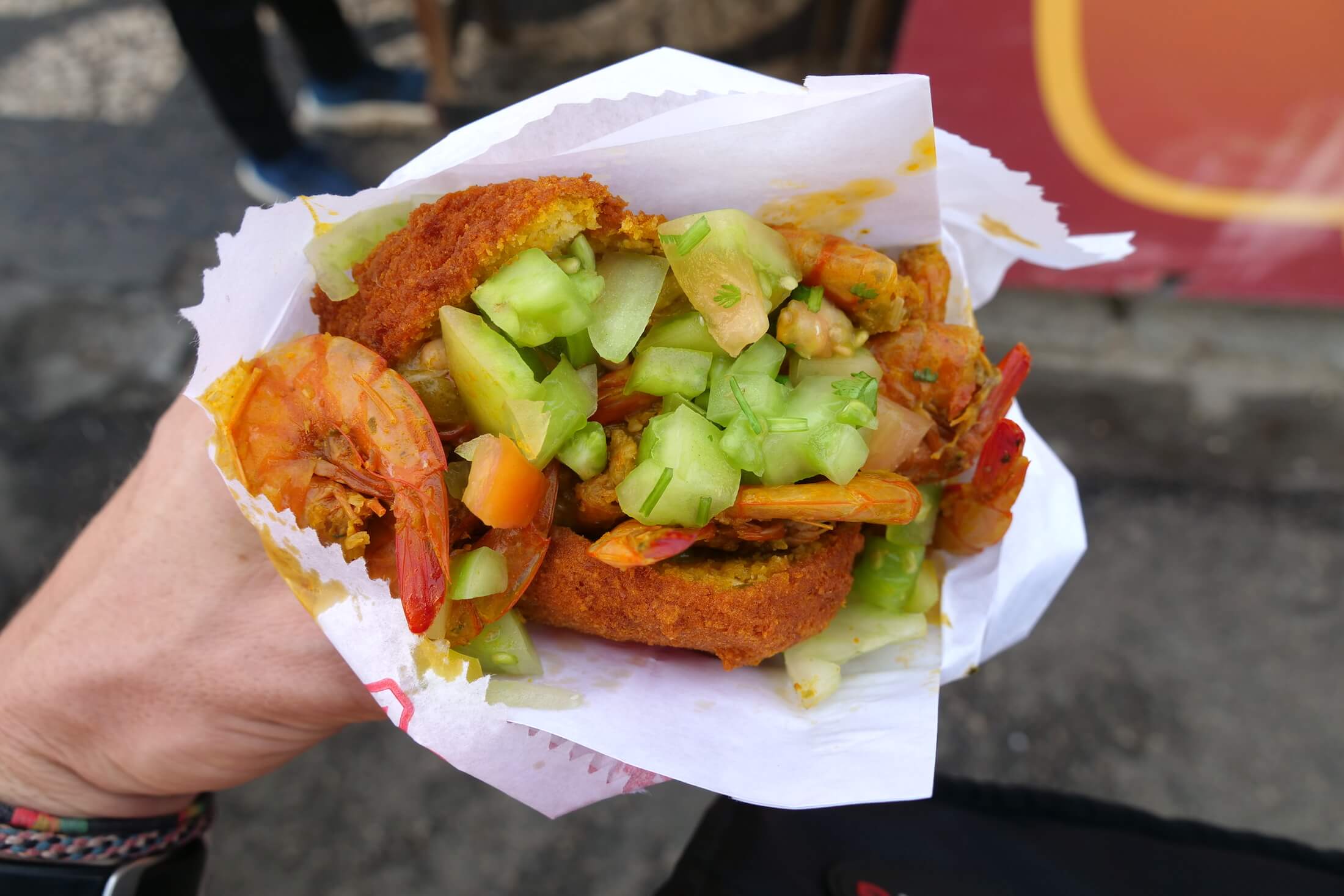
How To Eat Acarajé
Carts selling acarajé are almost like mini-buffets in Salvador, where all the options are laid out in front of you.
Acarajé is a very easy food to order, and its both wonderfully fun and so wonderfully messy to eat.
The Strategy is… No Strategy
Different people have different strategies, but I find that nothing feels better than just going in face first.
The child in you will rejoice because not only is it acceptable to fill this ‘sandwich’ far beyond capacity, its pretty much expected that ingredients will be delightfully overflowing by the time you start to eat.
Pick whatever looks good, but if you’re like me, then I’m assuming you’re going to want it all.
Black-eye peas are where this dish begins though, and let now me tell you about this amazing dendê oil…
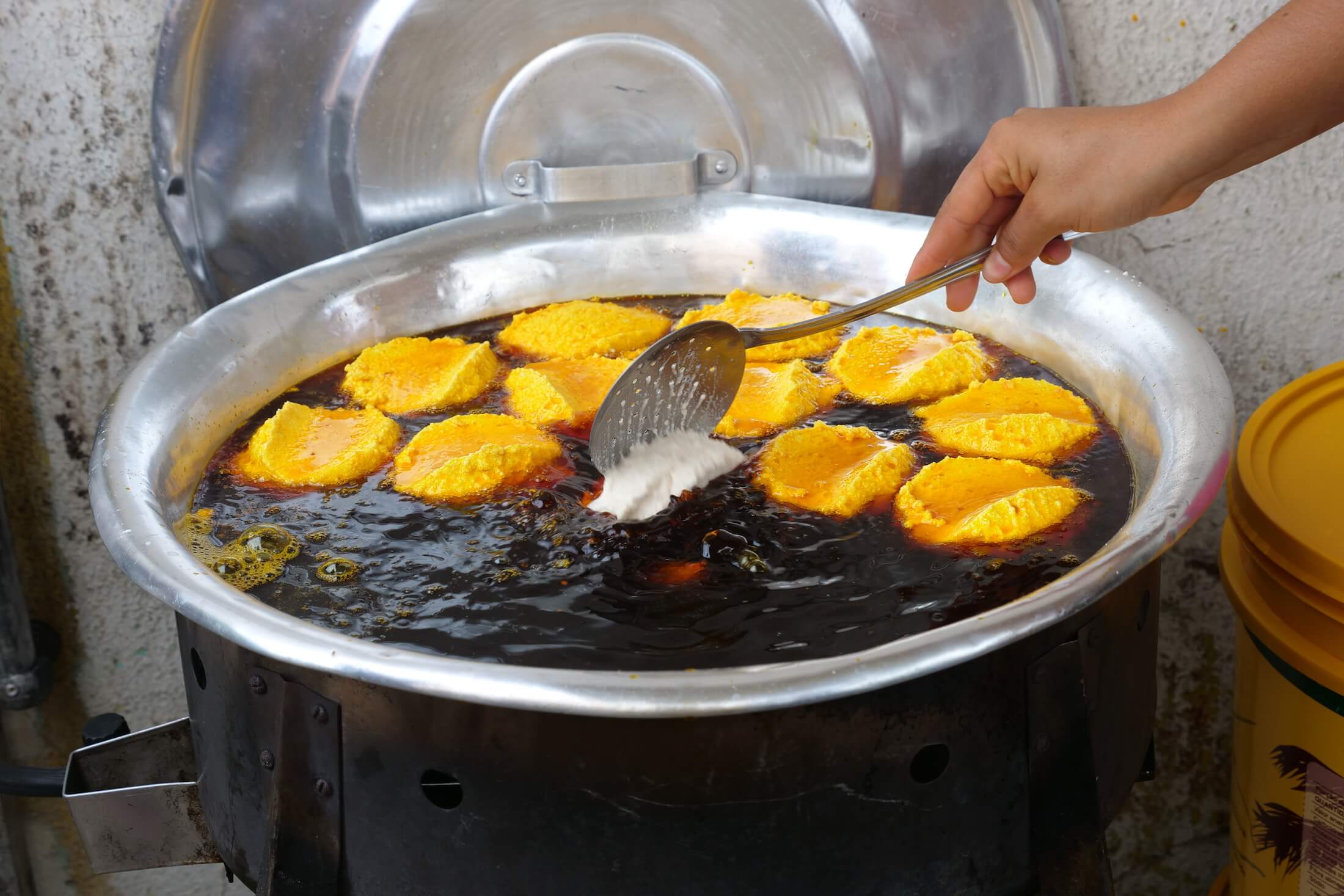
Black-Eyed Pea Patties and Dendê Oil
The two key ingredients to this food are the black-eye pea batter, and a type of palm oil (which is known locally as Dendê oil).
In this part of Brazil, there is a local belief that not only is dendê oil healthy, but foods that include dendê are foods worthy of use in ceremonies, and local Bahian religious traditions.
Get exclusive updates
Enter your email and I’ll send you the best travel food content.
Some believe that this oil even rejuvenates the body, that this oil is good for the soul!
After falling in love with acarajé for myself recently, I won’t argue with that belief at all.

Dendê (A Healthier Palm Oil)
The dark color of this red palm fruit oil is natural, and – although this may come as a surprise – it is much more healthy than deep frying using palm kernel oil (the more commonly known type of ‘palm oil’).
African Red Oil Palms are abundant in South America, and although its uses are similar, African red palm nuts contains much less saturating fats than the more common palm kernel nuts.
Deep Flavor of Red Palm Oil
Enough about health though, and back to the taste – cooking in this way also makes the acarajé black-eye pea bun so incredibly and wonderfully crispy – this is just the thing you want after your long day at work.
In my opinion this is the most delicious way to have this food, and you can start thinking about other healthy options after one (at least) of this type of acarajé patty.
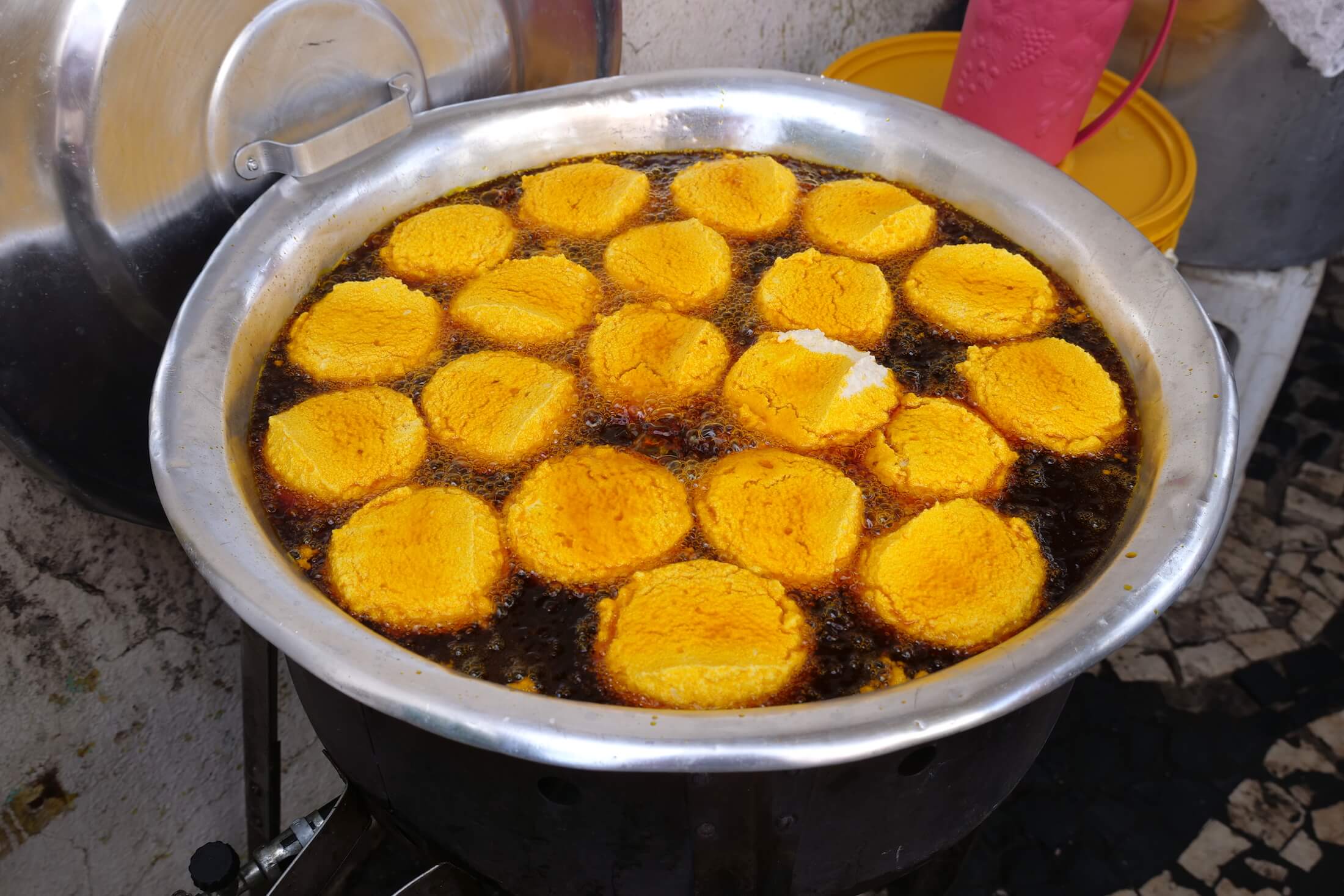
Make Your Selection
As the next batch of frying-oil buns are ready, step up to the cart, and choose your fillings.
Try to contain your hunger for just one more tantalizing minute, and enjoy watching as your miniature masterpiece of Salvador beauty takes form.
Acarajé da Ivone
Speaking of street carts, if you do happen to visit Salvador, then do yourself a favor and find the street cart of Acarajé da Ivone.
Few people have been making acarajé in this town for longer than Dona Ivone, and her acarajé making-skills and experience will just blow you away.
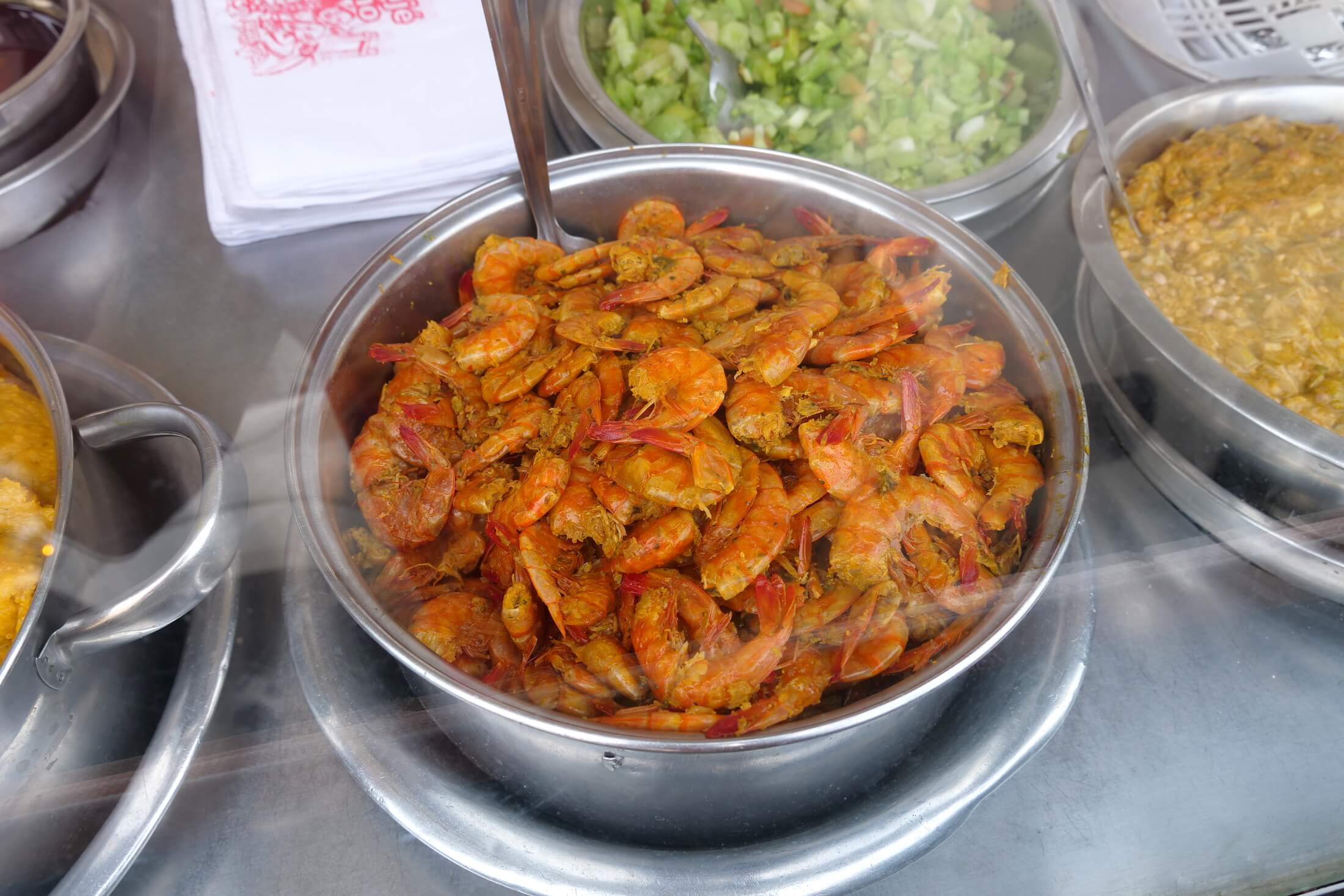
Your Acarajé Options
There will always be options when it comes to acarajé, its just a wonderfully customizable sandwich, but the standard combo needs to have these three main things.
- A gooey paste (either manioc or okra) which goes onto your black-eye pea bun first. This sort of gives moisture to the entire sandwich for each bite, as the bun can often be quite thick (wonderfully filling).
- A fresh ingredient, like a green tomato salad. This usually includes onions and bits of cilantro as well.
- Finally, a topping layer of salty shrimp (camarão do sal), which cooks in some kind of dry spice blend, and is not too spicy heat-wise, but is wonderfully and deeply flavorful. Not only that, but it smells absolutely gorgeous as well!
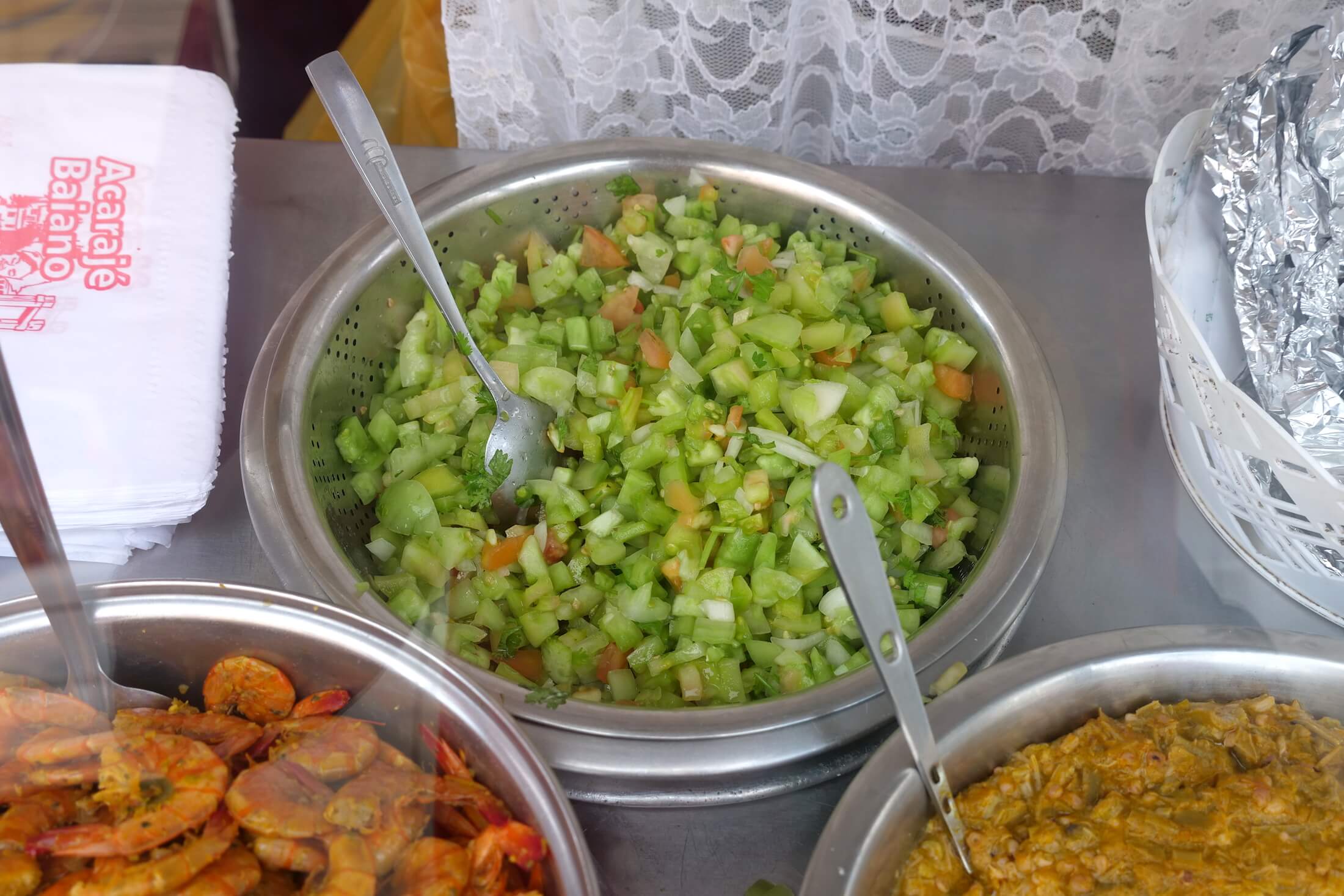
Additional Toppings
South American food uses huge amounts of manioc (cassava) in an absolutely mind-boggling amount of ways. I can tell you of no place more delicious to explore these varieties though, than in North and North-East Brazil.
One common addition to acarajé is ‘vatapá,’ which gets its yellow color from dendê oil (and also includes manioc flour, ground peanuts, and ground chashews)

Vatapá
This vatapá paste is a favorite food of Belém, in the neighboring state of Pará, and it is delicious when eaten simply over rice on its own as well (see a video here of us eating an amazing Amazon food called Tacacá).
Dendê oil, the same oil that they use to fry the patties, gives the red and brown colors you see in so many recipes, including vatapà.
Necessary in so many recipes in this part of the world, the dênde oil is also a part of the chili oil sauce that you see behind the vatapà bowl on this street food cart.
Integrating the rich flavor of dênde oil into so many levels during the preparation of acarajé – and you wouldn’t want it any other way.
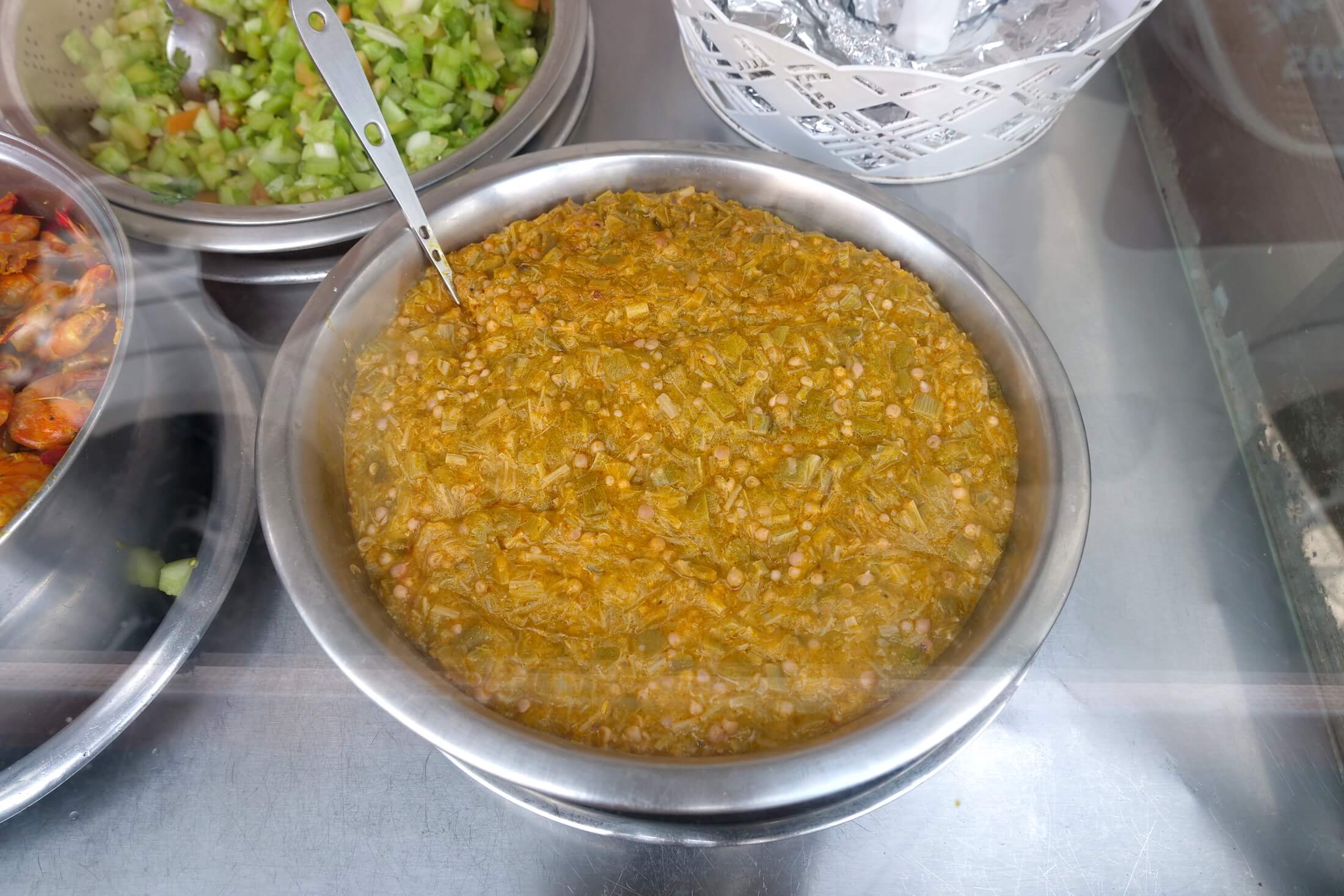
Caruru
Another option might be caruru, which is a gloriously gooey and spicy paste of okra (lady fingers), and cashew nut paste.
I love this food over rice, and also remember a great meal eating it with another Afro-Brazilian food called bobo. You can check out this great restaurant right here, in another area of the city of Salvador, at Boteca de Janela.
Second to Last Step – Chili Oil
Finally, any and every food in Brazil tastes even better with the addition of Brazil’s favorite chili oil.
Seriously, the flavor in Brazilian peppers is unlike any other pepper vibrancy you’ll experience – and the same is true for the pepper’s spicy heat! Incredibly hot peppers here, enough to light up even the most experienced chili lover.
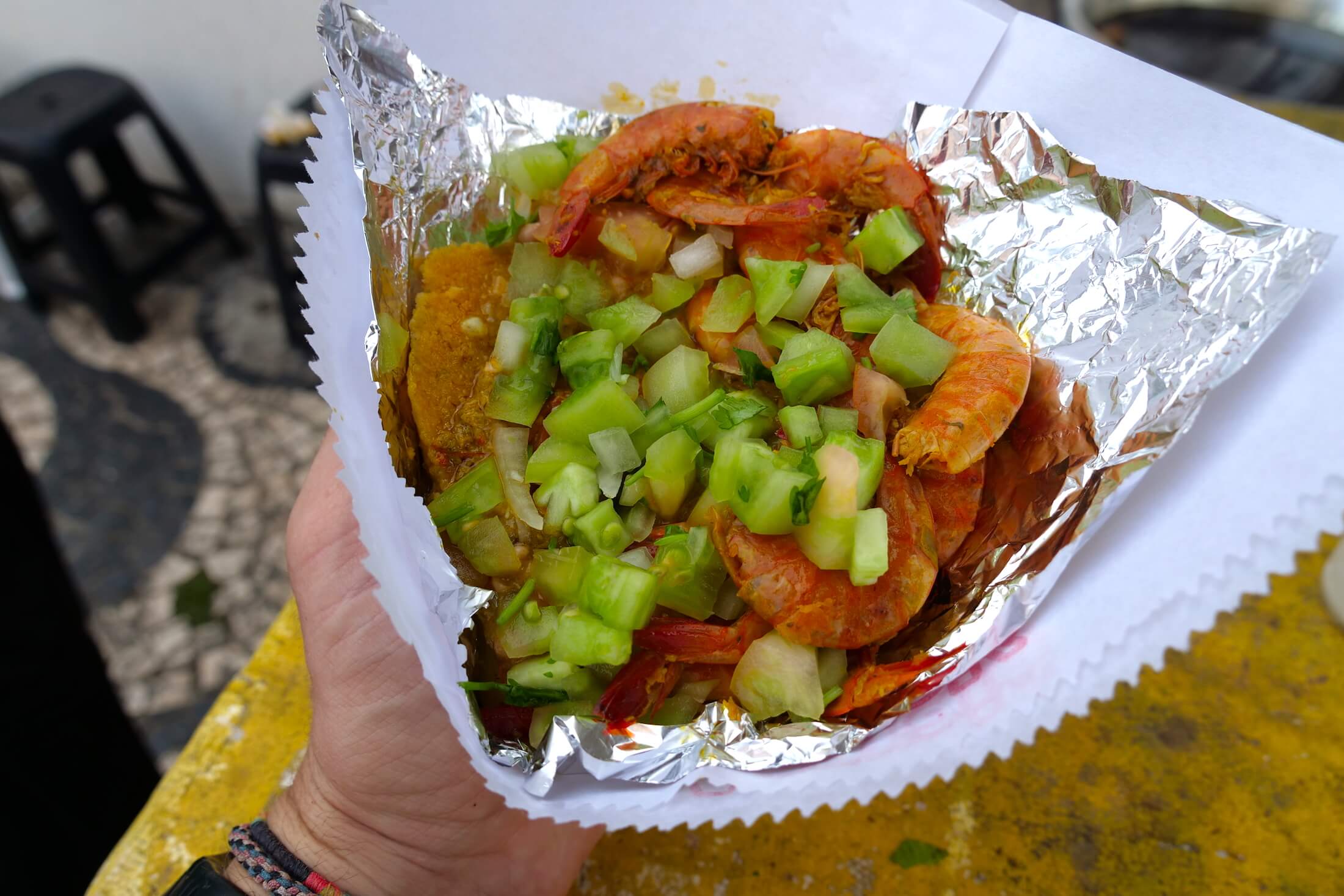
So Hearty Its Hard To Describe
Finally, you have your sandwich, and all is well in the world. I know that my eyes were focusing on nothing but my deep-fried bun by this point, I am sure you’ll experience this as well.
The heart-warming, mouth-watering, stomach-filling goodness of Acarajé is honestly hard to put into words.
Its not quite a meal, but it is an extremely hearty snack if you’re thinking of it that way. Each bite is so full of flavor its mind-blowing – the salty shrimp, the delightfully warm and gooey okra and manioc paste (vatapá), and finally the bright combo of the green tomatoes, cilantro, and finally the chili.
Enjoy every bite, and prepare yourself for round two (because in my opinion you really need to have at least one of each main type when you’re here).

Abará is also Amazing Here
A second sandwich-style food commonly served in Bahia is Abará (you’ll remember the names after having them a few times I’m sure). Instead of deep-frying the abará though, they steam many of the ingredients in this food, making it actually even more filling than acarajé.
Incredible, but true, and it was all we could do to finish one of these after our first round of acarajé.
Abará is truly one of the most delicious, budget-friendly ways to fill a stomach that I’ve found in a long, long time.
Bonus Round for True Lovers
Finally, for the true Acarajé addicts, it is even acceptable to have three in a single sitting – please let me know in the comments section below if you (or even anyone you eat with) manages this feat!
Visiting the daughter of Dona Ivone here is a wonderful experience, I would like to say a huge thank you to her as well.
Meeting and hanging out with her friends (as we devoured yet another round of acarajé greatness) was one of the most fun and delicious memories of the time in Salvador, it made this meal even better when having the chance to get to know them a bit, (and of course, enjoy as they laughed at our very obvious acarajé addictions).
Name: Acarajé de Ivone
Location: Google Maps (link here)
Hours: Open Daily, 3pm to 8pm, Sunday 10am to 3pm
Price: R$6 for basic acarajé, up to R$10 for shrimp (US$1.50-2.50)
Endless Friendliness in Brazil
This entire meal here also serves as a perfect example of the friendliness and warm hospitality we were receiving during our entire trip to Brazil (I’m totally certain you will receive the same here in Salvador, or anywhere you go).
Brazil is just full of wonderful places to visit, let alone when you Travel for Food. But I couldn’t recommend more that you include a visit to Salvador during your trip, a visit to Bahia is a must, this wonderful state on the Eastern coast of Brazil.

Second Trip to Bahia?
Acaraje is one of those foods that I find myself dreaming about uncontrollably, almost to the point where I want to just try to make one myself, or buy another plane ticket directly to Salvador in Bahia.
While the ingredients are not too complex, they are time-consuming to assemble. Besides that though, most of the raw ingredients are very specific to the tropics (to make it, you will likely have to buy all of these ingredients in a can).
Outside of the two cultures which create this food (West-Central Africa, and Eastern coastal Brazil), it would therefore be quite a challenge to assemble the sheer amount of flavor you get when you have this food fresh.
(And, so, we will now start to think about a second trip to Bahia…)
Do Not Miss This Food
You absolutely cannot miss having (at least one) Acarajé black-eye pea sandwich, with all the stuffings, whenever you have the chance.
Eating this food should be near the very top of your list of Things to Do in Brazil, not only Salvador – its even worth a visit just to eat Acarajé!
We hope you enjoy this article, all the delicious photos, and here are a few more stories and links to some other meals that made for a truly wonderful trip to the amazing country of Brazil.
Links – Local Seafood Feast in Salvador (here), Two Amazing Market Meals in Salvador (here), and Your Ultimate Salvador Travel Guide (here).

Protect The Dende!
I would like to give you just a bit more information on Dende oil, just in case you didn’t have enough reason already to immediately track down some Acarajé.
The process of collecting this oil is difficult, and thus its high value (valuable because it has to be done by hand). The nuts which make this red palm oil are smaller than palm oil kernels, and so the harvesting is not done by a machine.
What this means for local eaters though, is that people are producing less and less dendê oil in traditional ways, and therefore fewer people nowadays are able to eat the foods of this dendê tradition.
Aside from ceremonies and local religious practices in Bahia, only places like Acarajé da Ivone in Salvador are still using pure red palm oil in their cooking process – so make sure you go out and support your local dendê traditions today!
Happy eating, thanks for your support, and see you for the next article.
Get exclusive updates
Enter your email and I'll send you the best travel food content.


